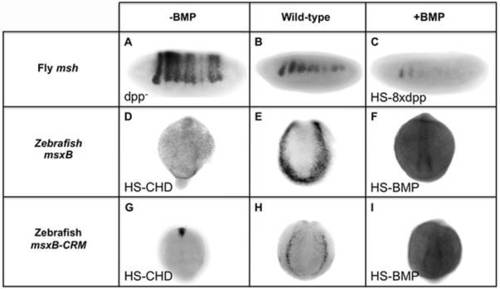- Title
-
BMPs Regulate msx Gene Expression in the Dorsal Neuroectoderm of Drosophila and Vertebrates by Distinct Mechanisms
- Authors
- Esteves, F.F., Springhorn, A., Kague, E., Taylor, E., Pyrowolakis, G., Fisher, S., Bier, E.
- Source
- Full text @ PLoS Genet.
|
Identification of vertebrate msx CRMs (A) Representation of the zebrafish msxB and mouse Msx1 loci depicting the location of the CRMs and vertebrate sequence conservation (Cons). For zebrafish, histone 3 lysine 4 single and triple methylation patterns indicative of open chromatin are also indicated. Block conservation tracks for select species are represented for both loci. (B) In situ expression driven by msx CRMs. Dorsal (anterior to the top) and lateral (anterior to the left) views of transgenic zebrafish embryos at the open neural plate stages (3–6 somites). Embryos were injected with either msxB-CRM or Msx1-CRM constructs driving gfp and stable transgenic lines were subsequently bred. Stable transgenic embryos were stained for msxB and gfp expression, which was detected by in situ hybridization. Both CRMs drive patterns resembling the endogenous msxB pattern. The zebrafish DNA isolated contains sufficient information to drive a pattern resembling the endogenous msxB expression pattern. The cloned mouse CRM also is capable of responding to regulatory cues in the zebrafish embryo to drive expression resembling that of the zebrafish msxB gene (as well as the endogenous Msx1 gene in mice [62]). Note that this embryo is tilted in a slightly more rostral direction than the other embryos shown from the dorsal perspective, which results in bands of anterior expression coming into view. (C) EMSA experiment in which a radiolabeled oligonucleotide probe carrying the zAE element (Msx11F in Fig. S3) was incubated with extracts from S2 cells over-expressing activated Tkv (to induce BMP signaling), Med and Mad. When the GC-rich region of the mad1 binding site is mutated (GCR1), pMM biding is abolished (the same loss of binding was also observed for the mutation in the mad2 site, GCR2 - see Fig. S3C). (D) Mutation of the pMM zAE site greatly reduces specific expression driven by the 671 bp msxB CRM. Dorsal (anterior to the top) and lateral (anterior to the left) views of injected zebrafish embryos (6–8 somites). Embryos were injected with GFP-reporter constructs under the control of the intact 671 bp msxB-CRM, a 30 bp mutant deleting the zAE (msxB-CRMDEL), or a point mutant version of the zAE that abolishes pMM binding – see panel C (msxB-CRMGCR1). Both zAE mutant constructs show greatly reduced reporter expression. Transient gfp mRNA expression was detected by in situ hybridization. |
|
Manipulating BMP signaling elicits opposite responses from msh and msxB in Drosophila and zebrafish embryos. Comparison of equivalent BMP manipulations in Drosophila (Dmel) and zebrafish (Drer) embryos and their effects on msh, msxB and msxB-CRM driving GFP assayed by in situ hybridization. All embryos are oriented with dorsal at the top. Drosophila embryos are oriented with anterior to the left, while zebrafish embryos are view from a posterior perspective. Loss of BMP signaling is Drosophila was examined in dpp null mutant (dpp) embryos (A) and ectopic BMP signaling was generated by heat induction of transgenic embryos carrying eight copies of a heat-shock dpp construct (HS-8xdpp) (C). In zebrafish, BMP signaling was reduced by heat induction of transgenic embryos carrying a Heat Shock Chordin construct (HS-CHD) (D, G), while BMP over-expression was accomplished by induction of transgenic embryos carrying a Heat Shock BMP2 construct (HS-BMP) (F,I). In dpp embryos, msh expression expands dorsally as shown also in Fig. 1B. In, contrast, in HS-CHD embryos, expression is weakened relative to the wild-type pattern for both the endogenous msxB gene (E) and msxB-CRM-gfp reporter construct (H). Drosophila HS-8xdpp embryos show reduced msh expression compared to wild type embryos (B) consistent with Dpp having a repressive action on msh expression, while zebrafish HS-BMP embryos exhibit ectopic expression of both the endogenous msxB gene and the GFP reporter gene driven by the msxB-CRM when compared to wild-type. |


